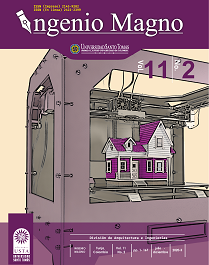(methodology for preliminary estimation of the hydrokinetic “h” darrieus turbine performance curve
Main Article Content
Abstract
Downloads
Article Details
DECLARATION OF ORGINIALITY OF SUBMITTED ARTICLE
With this document, I/We certify that the article submitted for possible publication in the institutional journal INGENIO MAGNO of the Research Center Alberto Magno CIIAM of the University Santo Tomás, Tunja campus, is entirely of my(our) own writing, and is a product of my(our) direct intellectual contribution to knowledge.
All data and references to completed publications are duly identified with their respective bibliographical entries and in the citations thus highlighted. If any adjustment or correction is needed, I(we) will contact the journal authorities in advance.
Due to that stated above, I(we) declare that the entirety of the submitted material is in accordance with applicable laws regarding intellectual and industrial property, and therefore, I(we) hold myself(ourselves) responsible for any complaint related to it.
If the submitted article is published, I(we) declare that I(we) fully relinquish publishing rights of the article to the University Santo Tomás, Tunja campus. As remuneration for this relinquishment of rights, I(we) declare my(our) agreement to receive two (2) copies of the edition of the journal in which my(our) article appears.
References
Dominguez, F., Achard, J. L., Zanette, J., & Corre, C. (2016). ‘’Fast power output prediction for a single row of ducted cross-flow water turbines using a BEM-RANS approach.’’ Renewable Energy, 89, 658–670.
Gorle, J. M. R., Chatellier, L., Pons, F., & Ba, M. (2016). ‘’Flow and performance analysis of H-Darrieus hydroturbine in a confined flow: A computational and experimental study.’’ Journal of Fluids and Structures, 66, 382–402.
Guedes, M. H. (2015). ‘’Transformando Venenos Em Remédios’’ (1st ed.).
Khan, M. J., Bhuyan, G., Iqbal, M. T., & Quaicoe, J. E. (2009). ‘’Hydrokinetic energy conversion systems and assessment of horizontal and vertical axis turbines for river and tidal applications: A technology status review’’. Applied Energy, 86(10), 1823–1835.
Kumar, D., & Sarkar, S. (2016). ‘’A review on the technology, performance, design optimization, reliability, techno-economics and environmental impacts of hydrokinetic energy conversion systems.’’ Renewable and Sustainable Energy Reviews, 58, 796–813.
Manwell, J. F., McGowan, J. G., & Roger, A. L. (2010). ‘’Wind Energy Explained. Theory, Design and Application’’ (Wiley (ed.); 2nd ed.).
Nunes, M. M., Brasil Junior, A. C. P., & Oliveira, T. F. (2020). ‘’Systematic review of diffuser-augmented horizontal-axis turbines.’’ Renewable and Sustainable Energy Reviews, 133, 110075.
Patel, V., Eldho, T. I., & Prabhu, S. V.(2017). ‘’Experimental investigations on Darrieus straight blade turbine for tidal current application and parametric optimization for hydro farmarrangement.’’ International Journal of Marine Energy, 17, 110–135.
Patel, V., Eldho, T. I., & Prabhu, S. V.(2019). ‘’Performance enhancement of a Darrieus hydrokinetic turbine with the blocking of a specific flow region for optimum use of hydropower.’’ Renewable Energy, 135,
Rodrigues, A. P. D. E. S. P. (2007). ‘’Parametrização E Simulação Numérica Da Turbina Hidrocinética
– Otimização Via Algoritmos Genéticos Universidade de Brasilia https://repositorio.unb.br/bitstream/10482/2350/1/2007_AnnaPauladeSousaParenteRodrigues. PDF
Rosato, M. A. (2019). ‘’Small Wind Turbines for Electricity and Irrigation’’ (CRC Press (ed.)). Taylor & Francis Group. https://taylorandfrancis.com/
Sheldahl, R. E., & Klimas, P. C. (1981). ‘’Aerodynamic characteristics of seven symmetrical airfoil sections through 180-degree angle of attack for use in aerodynamic analysis of vertical axis wind turbines’’.
Shiono, M., Suzuki, K., & Kiho, S.(2000). ‘’Experimental study of the characteristics of a Darrieus turbine for tidal power generation.’’ Electrical Engineering in Japan (English Translation of Denki Gakkai Ronbunshi), 132(3), 38–47.
Talukdar, P. K., Kulkarni, V., & Saha, U. K.(2018).’’ Field-testing of model helical-bladed hydrokinetic turbines for small-scale power generation.’’ Renewable Energy, 127, 158–167.
Thönnißen, F., Marnett, M., Roidl, B., & Schröder, W. (2016). ‘’A numerical analysis to evaluate Betz’s Law for vertical axis wind turbines.’’ Journal of Physics: Conference Series, Conference.
Tong, W. (2010). ‘’Wind Power Generation and Wind Turbine Design’’ (U. Kollmorgen Corp. (ed.)). WIT Press.
Vermaak, H. J., Kusakana, K., & Koko, S. P. (2014). ‘’Status of micro-hydrokinetic river technology in rural applications: A review of literature.’’ Renewable and Sustainable Energy Reviews, 29, 625–633

